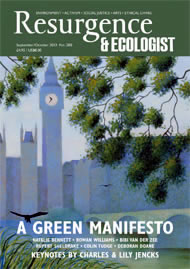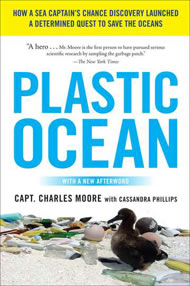In 1997, Captain Charles Moore steered his catamaran into the doldrums of the mid-Pacific Ocean, hoping to catch winds further south that would push his boat back to California. While sailing through this stretch of water, Moore made a shocking discovery – the ocean was filled with plastic.
Mainstream media has often referred to this accumulation of plastic as a “floating island” or a “mountain of trash”. In Plastic Ocean, Moore sets the record straight, describing it as “plastic soup … lightly seasoned with plastic flakes, bulked out here and there with ‘dumplings’: buoys, net clumps, floats, crates, and other ‘macro debris’”. In his hometown of Alamitos Bay, south of Los Angeles, Moore had founded the Algalita Marine Research Institute in 1994 to help clean up the coastal waters. But he couldn’t believe he had found plastic in the middle of the Pacific Ocean. His determination to do something about it shaped his path for the next 15 years.
Plastic Ocean chronicles Moore’s journey as he evolves into a citizen-scientist intent on curbing plastic pollution. Shortly after returning to California, Moore organised a research expedition back to the rubbish zone in the Pacific, an area now called the Great Pacific Garbage Patch. He and his crew trawled for plastic samples, yielding alarming results. Plastic outnumbers life-giving zooplankton by a factor of six to one. Filter feeders appear to ingest more plastic than plankton, suggesting that plastic has the potential to disrupt the entire marine food chain.
While much of his journey takes place in the rough waters of the ocean, Moore embarks on an equally rough ride on land. To obtain the best exposure for his research, he set his sights on publication in a peer-reviewed scientific journal. With humour and humility, he describes the challenges of navigating his way to scientific acceptance. First he has to learn the ropes of writing a research paper. Then he has to fight for his voice to be heard at scientific conferences, often sponsored by the very corporations responsible for plastic proliferation.
None of these obstacles deters Moore. In fact, they impassion him further. He sails his catamaran back to the mid-Pacific to collect additional samples. He co-authors more research papers. He spreads awareness about plastic pollution in conferences, films and news segments, and on late-night talk shows.
Spliced with Moore’s own story is the story of plastic itself. As grandson of a past president of Hancock Oil, Moore speaks with authority about converting oil into different types of plastic. Plastic consumption burgeoned after World War II with the invention of disposable products. Although Moore acknowledges the many benefits of plastic, he argues that single-use plastics like shopping bags and drink bottles have contributed to the degradation of our natural world. On one voyage, he paints an eerie scene of crisp-looking plastic bags fluttering across the seascape. “We’re in the middle of the ocean, surrounded by a sea of plastic shopping bags,” he says. “It’s as if a tornado tore the roof off a floating shopping mall just beyond the horizon line.”
Yet, as Moore illustrates, the problem of plastic pollution is much more than aesthetic. In the chapter Bad Chemistry, he explains how new research shows that plastic acts like a sponge, soaking up other contaminants present in the ocean. Plastic is already toxic in itself, poisoning the filter feeders that ingest it. But as plastic works its way up the oceanic food chain, toxicity escalates.
Plastic Ocean is an incredibly important book, explaining the urgency of the plastic pollution problem. Ocean conservation efforts tend to focus only on issues like overfishing, acidification, and sea-level rise. Yet plastic pollution poses another big threat, and we had better start paying more attention right now.
While the hard-hitting facts in this book can feel a little depressing, Moore provides plenty of hope in possible solutions. For instance, he endorses “chemical recycling”, a process that cracks plastic polymer back to its monomers for reuse. (However, he notes that this process is “not perfect by closed-loop standards”.) He also advocates marine-biodegradable plastic that aquatic bacteria can break down. The most effective path to change, Moore suggests, is a consumer groundswell against plastics: “In my decade and a half in the trenches,” he writes, “I’ve seen tremendous growth in awareness.”
Plastic Ocean will generate and increase this awareness about plastic pollution. I certainly feel different about plastic – and about the changes I could make to help save the oceans.








